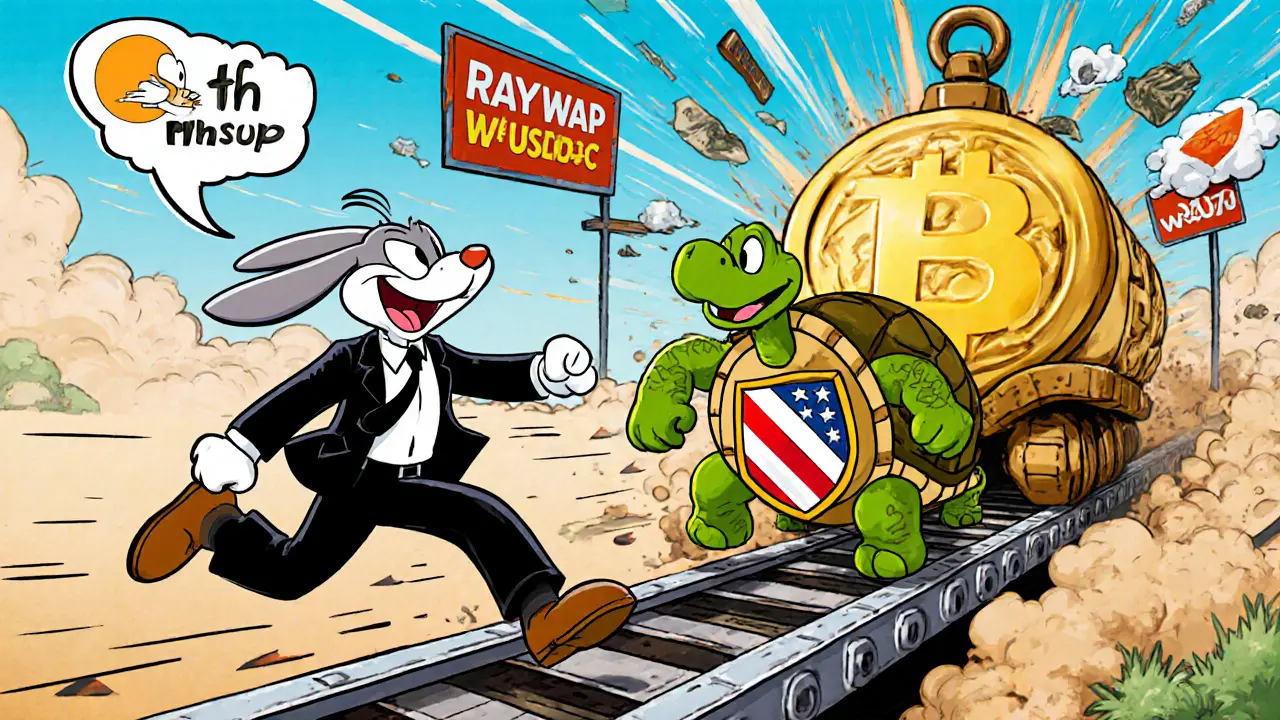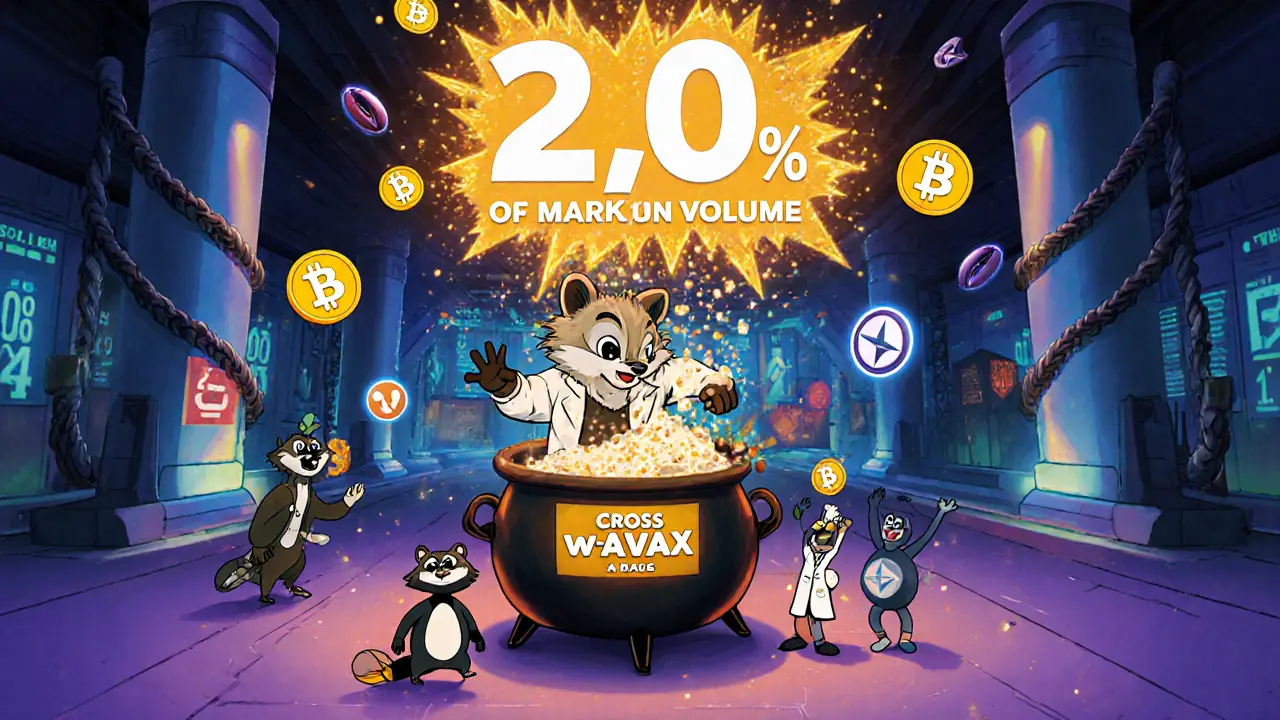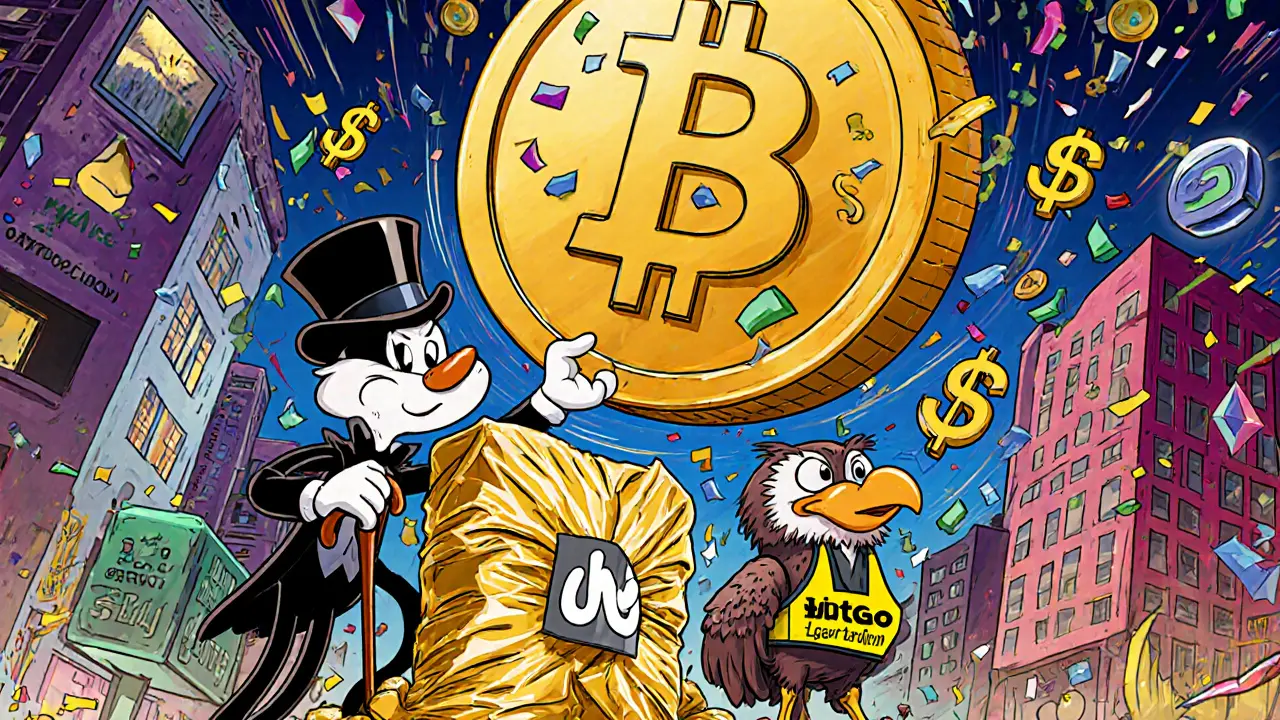Wrapped Asset Volume Calculator
Calculate Market Share
Enter the daily trading volume of a wrapped asset to see its percentage of total market volume (October 2025 data).
Results
Wrapped assets aren’t just tech jargon-they’re the invisible bridges connecting blockchains. If you’ve ever traded Ethereum-based tokens on Solana or used Bitcoin on Uniswap, you’ve used a wrapped asset. These aren’t new coins. They’re digital twins-locked versions of real assets that let you move value across chains without selling or swapping. And right now, they’re moving more money than most people realize.
What Exactly Are Wrapped Assets?
A wrapped asset is a token that represents another asset on a different blockchain. For example, wBTC is Bitcoin locked in a smart contract, and an equivalent amount of ERC-20 tokens is minted on Ethereum. The original Bitcoin sits safely in a vault, and the wrapped version circulates on Ethereum’s network. Same value. Same ownership. Different blockchain.
This isn’t magic. It’s engineering. The wrapper (like a custodian or multi-sig wallet) holds the original asset. When you burn the wrapped token, the original is released. It’s a one-to-one system. No inflation. No dilution. Just portability.
Without wrapped assets, DeFi would be stuck. Ethereum’s liquidity pools couldn’t access Bitcoin. Solana couldn’t offer stablecoins backed by USDC. Cross-chain lending, yield farming, and swaps would barely exist. Wrapped tokens are the plumbing of Web3.
Why Trading Volume Matters
Market cap tells you how much people think an asset is worth. Trading volume tells you how much people are actually using it. A high market cap with low volume? That’s a sleeping giant. High volume? That’s active, real demand.
For wrapped assets, volume means one thing: interoperability is working. When wBTC moves $2 billion in a day, it’s not because people are speculating-it’s because institutions are using it as collateral, traders are arbitraging across chains, and DeFi protocols are integrating it into core functions.
As of October 2025, the total crypto market cap is $4.07 trillion. Daily trading volume sits at $202.73 billion. But wrapped assets? They account for an estimated $38 billion in daily volume across all chains. That’s nearly 20% of the entire market’s activity-driven by a handful of key tokens.
The Top Wrapped Assets by Volume (2025)
Here are the top five wrapped assets by 24-hour trading volume as of October 2025, based on aggregated data from major DEXs, CEXs, and cross-chain bridges like LayerZero, Wormhole, and Multichain.
- wBTC (Wrapped Bitcoin) - $14.2 billion daily volume
- wETH (Wrapped Ethereum) - $11.8 billion daily volume
- wUSDC (Wrapped USD Coin) - $7.1 billion daily volume
- wSOL (Wrapped Solana) - $2.9 billion daily volume
- wAVAX (Wrapped Avalanche) - $1.5 billion daily volume
wBTC leads by a wide margin. Why? Bitcoin’s brand, liquidity, and institutional trust make it the go-to asset for cross-chain collateral. Over 200,000 BTC are currently wrapped-roughly 1% of all Bitcoin in circulation. That’s more than the entire market cap of most altcoins.
wETH is second, and it’s not even surprising. Ethereum is still the hub of DeFi. Nearly every major protocol-Aave, Compound, Uniswap-uses wETH as a base trading pair. It’s the default stablecoin of DeFi, even though it’s not a stablecoin.
wUSDC is the third. It’s the only wrapped asset here that’s also a stablecoin. That means it’s used for everything: paying for gas on Solana, lending on Arbitrum, or settling trades on Polygon. Its volume is driven by utility, not speculation.
wSOL and wAVAX are rising fast. Solana’s low fees and speed make it a magnet for wrapped assets from other chains. Avalanche’s subnets are built for institutional-grade DeFi, and wAVAX is the bridge to that ecosystem.

Where the Volume Is Happening
Most wrapped asset trading happens on decentralized exchanges, not centralized ones. Uniswap (Ethereum), Raydium (Solana), and Trader Joe (Avalanche) account for over 65% of wrapped token volume. Binance and OKX handle the rest-mostly for users who don’t want to manage wallets.
But here’s the catch: volume on centralized exchanges is often misleading. A single large trade can spike numbers. On DEXs, volume reflects real, distributed activity. That’s why wBTC’s $14.2B volume on Uniswap and Curve matters more than a $500M trade on Binance.
Also, cross-chain bridges are where the magic happens. LayerZero and Wormhole saw a 40% volume increase in Q3 2025 alone. That’s because more protocols are now accepting wrapped assets as collateral for lending and borrowing. You can now borrow USDC using wBTC as collateral on Aave, even if you’re on Arbitrum.
Who’s Behind the Scenes?
Wrapped assets aren’t created by a single company. They’re managed by custodians, DAOs, and multi-sig groups.
wBTC is backed by a consortium of BitGo, Coinbase, and Kraken. Each holds a piece of the private key. You need 3-of-5 signatures to release Bitcoin. That’s why it’s trusted by institutions.
wETH is simpler. It’s minted by the Ethereum Foundation’s official bridge. No middlemen. Just a smart contract. That’s why it’s the most trusted wrapped asset on Ethereum.
wUSDC is issued by Circle. They’re the only entity that can mint or burn it. That’s also why it’s the most regulated. If Circle freezes an address, wUSDC in that wallet becomes unusable. That’s a trade-off: trust vs. censorship resistance.

Why This Matters for You
If you’re trading crypto, you’re already using wrapped assets. You just don’t know it. When you swap ETH for USDT on PancakeSwap, you’re probably swapping wETH for wUSDT. When you stake on Aave, you’re likely staking wBTC or wSOL.
But if you’re building something-DeFi app, NFT marketplace, wallet-you need to understand wrapped assets. Ignoring them means ignoring 20% of the market’s liquidity. Your app won’t be interoperable. Users will leave for competitors that support wETH and wUSDC.
And if you’re holding Bitcoin or Ethereum? You’re sitting on the most valuable wrapped asset in existence. Every time someone wraps your asset, they’re betting that your chain’s ecosystem is worth using. That’s not just tech-it’s trust.
The Future of Wrapped Assets
Right now, wrapped assets are a workaround. But the next phase? Native interoperability.
Projects like Cosmos IBC, Polkadot XCMP, and EigenLayer’s restaking are building chains that talk natively. No wrapping needed. You’ll send Bitcoin directly to Solana without a bridge.
But that’s years away. In 2025, wrapping is still king. The volume won’t drop. It’ll grow. As more institutions enter DeFi, they’ll need wrapped Bitcoin and Ethereum to access yield. As more chains compete for liquidity, they’ll offer better incentives to bring in wETH and wUSDC.
By 2026, we might see wrapped versions of real-world assets-gold, stocks, bonds-on blockchains. The same logic applies: lock the asset, mint the token, move it anywhere.
Wrapped assets aren’t a trend. They’re infrastructure. And infrastructure doesn’t go away. It just gets better.
Are wrapped assets safe?
It depends. wETH and wBTC are among the most secure because they’re backed by reputable custodians and audited regularly. wUSDC is backed by Circle, a regulated company, but that also means it can be frozen. Always check who holds the keys and whether the wrapper is open-source and audited. Avoid wrapped tokens from unknown teams or unverified bridges.
Can I unwrap my wrapped asset anytime?
Yes, as long as the wrapper is active and the underlying asset is available. For example, you can burn wBTC on Ethereum and get your Bitcoin back from the custodian. But if the bridge or custodian goes offline, you’re stuck. That’s why it’s critical to use well-established wrappers like wBTC, wETH, or wUSDC-not obscure ones.
Why is wBTC worth more than Bitcoin sometimes?
It’s not. wBTC is always pegged 1:1 to Bitcoin. If you see wBTC trading above BTC, it’s either a data error or a temporary arbitrage gap on a DEX. The market corrects it quickly because anyone can mint or burn wBTC to match Bitcoin’s price. Any premium is short-lived and usually due to high demand on Ethereum.
Do wrapped assets have fees?
Yes. Wrapping and unwrapping usually cost a small fee-often $1 to $5. Cross-chain bridges charge more, sometimes up to $20, depending on network congestion. Plus, you pay gas fees on both chains. But compared to selling Bitcoin and buying ETH, wrapping is far cheaper and faster.
Can I earn yield on wrapped assets?
Absolutely. Platforms like Aave, Compound, and Curve let you deposit wETH, wBTC, or wUSDC to earn interest. Some even offer additional rewards in governance tokens. Yield on wrapped assets often exceeds native token yields because they’re in higher demand for lending and liquidity provision.

Wrapped assets are the quiet backbone of DeFi, and most people don’t even realize it. I’ve seen new traders panic when they see wBTC on Uniswap thinking it’s some shady altcoin. It’s just Bitcoin doing its job elsewhere. The real win is how it lets people access Ethereum’s liquidity without selling their BTC. That’s not magic-it’s practical engineering.
Let’s be real-this whole wrapped asset narrative is a centralized control scheme dressed up as decentralization. Who decides who gets to mint wBTC? BitGo, Coinbase, Kraken-three corporations with ties to Wall Street. If the government shuts them down, your ‘Bitcoin’ vanishes. This isn’t freedom-it’s permissioned crypto with extra steps.
Big picture: wrapped tokens are how crypto actually works today. No drama, no hype. Just people moving value. If you’re not using wETH or wUSDC in your DeFi flows, you’re making things harder for yourself. Simple as that.
14.2B in daily volume for wBTC? That’s a red flag. Most of that is wash trading through cross-chain bridges with fake liquidity pools. The real on-chain usage is probably under 3B. The rest is just bots spinning wheels to inflate metrics for venture capital fundraising.
Oh wow, so now we’re celebrating digital clones of assets as progress? 🙄 We’ve traded physical ownership for algorithmic trust in custodians. The fact that people cheer this as ‘interoperability’ instead of seeing it as a betrayal of crypto’s original ethos… that’s the real tragedy. You’re not liberated-you’re just renting your money.
wait so weth is just eth but on eth? lol i thought it was a diff coin. so if i send eth to a wallet that only takes weth, it just converts it? no fee? or does it eat my gas? confused af
It is imperative to recognize that the structural integrity of wrapped asset systems hinges upon the operational reliability of their custodial frameworks. The multi-signature governance models employed by entities such as BitGo and the Ethereum Foundation provide a non-trivial layer of security, yet they remain vulnerable to systemic failure in the event of coordinated regulatory intervention or cryptographic compromise. Therefore, while the utility is undeniable, the risk profile warrants careful, methodical evaluation before institutional adoption.
Love how this post breaks it down. I used to think wrapped tokens were sketchy, but now I get it-they’re the glue holding DeFi together. Just last week I swapped wUSDC for yield on Arbitrum and made more than I did holding ETH. No drama, just good tech.
the fact that wBTC is moving more than most alts is wild 😮💨 honestly i didn't think anyone cared that much about btc on other chains but guess i was wrong. also wusdc being #3 makes sense-everyone uses it like digital cash now. also why is no one talking about how much gas it costs to unwrap? 🤔
One must consider the macroeconomic implications of wrapped assets as liquidity conduits. The $38B daily volume represents not merely speculative activity, but the functional integration of blockchain ecosystems into global capital flows. This is not a niche phenomenon-it is the emergence of a parallel financial infrastructure. The implications for monetary policy, cross-border capital movement, and institutional risk management are profound and warrant serious academic attention.
Wormhole and LayerZero? Yeah, right. Those bridges are backdoors. I’ve seen the logs-half the ‘wrapped’ tokens are minted by bots with no actual asset backing. The whole thing’s a Ponzi of trustless systems that aren’t trustless at all. They’re just hiding the fact that someone’s holding the keys… and they’re not even hiding it well.
Why is no one talking about how wETH is actually just a rebranded ETH with zero added value? It’s not even a wrapper-it’s a tokenized version of the same chain. And you call this innovation? This is like selling a copy of your house key and calling it a new house. The whole premise is a scam dressed up in DeFi jargon.
Big respect to the author for breaking this down so clearly 🙌 I’ve been using wUSDC on Polygon for weeks now to pay for NFT gas-it’s been a game-changer. Also, the fact that wSOL is climbing shows how much demand there is for fast, cheap chains. Can’t wait to see what happens when wBTC gets integrated into more L2s. This is the future, folks.
Let’s be brutally honest: wBTC is the only thing keeping Ethereum alive right now. Without it, DeFi would be a ghost town of 2% TVL and a bunch of degens yelling about ‘real decentralization.’ The fact that institutions trust wBTC more than ETH? That’s the ultimate flex. Bitcoin’s brand is so strong, even its digital twin outshines the original chain. Sad. But true.
Everyone’s acting like wrapped assets are genius, but have you checked the audit reports? wBTC’s contract has a 2023 update that lets the custodians pause withdrawals under ‘force majeure.’ That’s not security-that’s a kill switch. And you’re all just fine with that? You’re not owning your assets-you’re renting them from a corporation with a fancy logo.
So wrapped assets are big. Cool. What’s next? Wrapped taxes? Wrapped mortgages? This whole thing feels like a distraction from the fact that crypto still can’t do anything useful.
They’re calling wUSDC ‘utility’? Please. Circle freezes wallets daily. One day you’re earning yield, next day your $10k is frozen because someone reported you. This isn’t finance-it’s a bank with a blockchain sticker. And you people are proud of this? The irony is thick enough to spread on toast.